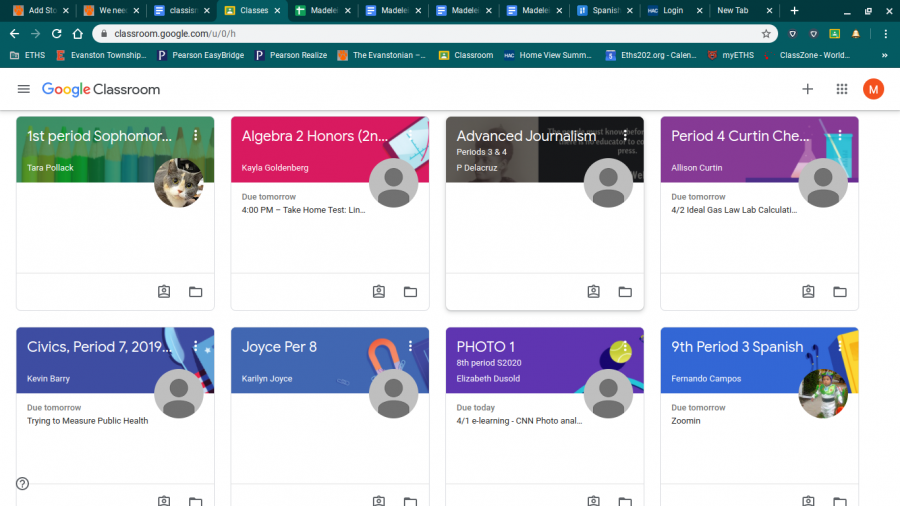Drawbacks of e-learning and what can be done to improve it
Student’s view of Google Classroom.
April 3, 2020
With school being out due to the unprecedented outbreak of COVID-19, millions of students across the country have been participating in e-learning, or online classes, these past few weeks.
Without strict schedules or classes to physically go to, e-learning allows students to work from their own home. Most schools see e-learning as the most productive way to combat the issue of being out of school. This has made myself and others question the effectiveness of this technology-driven learning, as well as what can be done to add structure and efficiency for students’ learning.
According to Education Week, as of March 30, 2020, all states have varying degrees of extended school closures. At least 124,000 U.S. public and private schools are closed, affecting at least 55.1 million school students.
In response to the virus, ETHS shut down, beginning March 16, and currently expected to extend until April 30.
At the beginning of the shutdown, the school implemented Act of God days, which are defined by the Illinois State Board of Education, as “used for a condition beyond the control of the district that poses a hazardous threat to the health and safety of the students.” This means the work done by students during this period did not impact their academic standing, and teachers did not take formal attendance. E-learning officially started Tuesday, March 31, which activated formal ways to document grades and attendance.
Though deemed as an effective tool for out of classroom learning, e-learning assignments have caused a lack of motivation among students because assignments are not mandatory and the school only requires a singular check in form.
“I don’t even feel like doing the school work because what’s the point of it’s not going to count anyways. I feel like they should have told us that the next two weeks won’t count for anything,” ETHS sophomore Maya Acacia explains during an Act of God day.
As well as working without an incentive, e-learning has proven to be difficult with the increased distraction of home environments in comparison to classrooms. Personally, living in a small house, it’s easy to hear most things going on outside of my own room, where I try to do most of my work, so I often have trouble concentrating. Public places like the library have been closed due to the pandemic, and so for students in similar positions, productivity can be low.
“I feel less motivated in my school work, my sleep schedule is nowhere near it has ever been, and my brain is turning to mush because all I can do is sit at home all day,” Acacia says.
Yet another large factor in the lack of interest and motivation is the content of the work, which often feels like busy work from my experience and for some other students like sophomore Ava Daye.
“In the majority of my classes, we’ve had just busy work, and other than that it’s just videos, like with new units in math. There hasn’t been much actual curriculum,” explains Daye.
As students sit down to complete their assignments, they often begin to question the purpose of the work. I know when I’ve sat down to complete my assignments, after a few hours I don’t feel like continuing because the work becomes repetitive and simple enough to do without too much effort. I end up completing the work easily, but question what I’m gaining. I’ve even experienced assignments that have little to do with what we’re doing in class, and rather just something to do. Often, students will find other things to do with their time.
For some, e-learning can also make it increasingly difficult to grasp concepts and effectively learn without a verbal explanation or example provided. Though some classes have utilized Zoom, an online video chat downloaded on students’ Chromebooks, if a student is not able to attend, schoolwork becomes more stressful. With little communication between teachers, many Zoom meetings have also been held at close to the same time, forcing students to keep track of different office hours, and sometimes have to pick one over another.
“I think it’s hard because if you don’t have Zoom or video chats with your teachers if you have questions you just have to figure it out on your own. I’m a visual learner so it helps doing it in class and having a schedule of what we’re going to do,” says Daye.
In classes like math, where the subject is often taught hands-on and with instructions from a teacher, this becomes an even bigger issue. Most math teachers have committed this issue by making videos for their students to aid them through lessons.
“I’ve found it’s difficult to fully support all of my students. With e-learning much of responsibility for learning is on the students, which is difficult for some of my students who aren’t self-starters. Many students, especially in math, rely heavily on the teacher to validate their steps; therefore the shift to e-learning is going to involve a change in learning styles,” math Algebra 2 and Geometry teacher Kayla Goldberg says.
So, if students are hesitant to sit down and complete the work, where does that leave us by the time we return to school? In order for e-learning to be effective, classes must provide clear directions and structure for students to engage and learn effectively.
“I think a students’ knowledge of the subject will vary from student to student depending on how that student does with taking responsibility for their learning,” explains Goldenberg.
A large part in assuring e-learning is effective is both students and teachers being responsible for their work and structure of the work. The use of Zoom in all classes is one way teachers can provide support and guidance to students to establish structure. This allows face to face communication similar to a classroom environment.
As we prepare for the unknowns of the last quarter, this use of e-learning has exposed us to education many students and teachers may not have experienced. Currently, e-learning has come with drawbacks that as an Evanston community we must voice if we want to see change in our community for this remote learning period.











